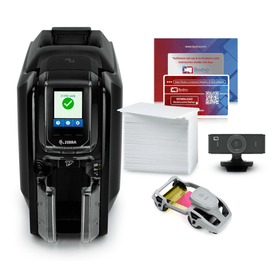Zebra’s ID card printers are known all over for the reliable way in which they deliver superior print quality at all times. They also form a wide selection range comprising several different models and options, aimed at meeting varying card-production requirements and budgets.
Zebra’s ID printers are well-designed machines that let you speedily render a variety of batch-card operations, whether you happen to be dealing in regular printing work or high-volume, one-time printing. Regardless of whether you need heightened security features in each card or not, and can make do with just the basic stuff, Zebra printers can meet your needs in the exact ways that you prefer. All aspects including flexibility, security, and print quality are upheld to high standards while making sure you do not exceed your operational budget.
Following are the main Zebra ID card printers, along with their summarized features. This information could prove helpful if you ever decided to buy from the brand.
Highlights (Highest to Entry-Level)
- ZXP8 Printer: This printer is capable of putting out high-definition prints using reverse transfer printing technology, which ensures maximum security in printed cards. The prints are of photo quality, and over the long term, the machine costs very less to own. It carries the full gamut of options for lamination and encoding and is highly versatile in the uses it can be put to.
- ZXP7 Printer: Meant for users who seek high performance and productivity, the Zebra ZXP7 is capable of printing both one-sided and dual-side. The prints are of photo quality, and this model is significantly cost-efficient. Advanced security is one of the givens when you print a card in this machine.
- ZXP3 Printer: Known for its markedly fast print speeds, this printer is capable of rendering both one-sided and dual-side jobs. You get professional quality cards as well as a bunch of security and encoding options, both of which only partly describe the usefulness of this model.
- ZXP1 Printer: Mainly appreciated for outputting quality prints inside an affordable budget while easing a user’s work, this printer nevertheless has its share of limitation. For one, it can print only single-sided, although the prints themselves are first-class. On the plus side, this machine is very compact, especially in comparison to the other models released under its brand. It is also manageable over a network.
ZXP7 and ZXP8: Similarities and Differences
Both of these high-tier models are known for meeting users’ high capacity, higher level needs. Each is an affordable option for achieving high-quality cards, whether printed single-sided or dual-sided. You get consistent performance that delivers sharp, clear and color-rich edge-to-edge images. The color control stays precise, the black text crisp, and the barcodes easily readable.
The ZXP7 and ZXP8 models are well matched to high-security environments, and overall, provide solid value as well as steady and practical results. However, there do exist significant differences between the two. Based on the content requirement, security needs, and card production volume you the ZX8 and ZX7 can be as different as night and day.
The main distinguishing factor between them is the printing technology used; where the ZXP8 uses retransfer printing technology that allows for thicker, higher-security cards, the ZXP7 uses a dye-sublimation thermal transfer to affix prints onto cards.
The ZXP8 is capable of printing perfectly on almost any smooth surface and keeps clear of most image quality issues commonly seen in direct-to-card printers. The HDP retransfer layer acts as another source of security and durability. You can use this printer to encode, print, and laminate, all at the same time. Meanwhile, the ZXP7 can reprint both full-color and monochrome, and although it lacks the more advanced features already mentioned, this printer can stretch its per-ribbon-roll printing capacity to twice as many black-and-white images, and fifth over the latter’s color image capacity.
ZXP1 and ZXP3: Similarities and Differences
Both the ZXP1 and ZXP3 are entry-level models, capable of outputting vivid colors, edge-to-edge expanse, and consistent performance. Each is well suited to environments with a basic requirement in terms of card production.
That said, there are a few significant differences between the two as well, the biggest of which had to do with speed and print capability. While ZXP1 can only handle single-sided printing, ZXP3 is able to print either way. The former’s printing capacity goes up to 500 monochrome card prints every hour, or 120 color single-sided ones. The ZXP3 takes this up a notch to 700 monochrome card prints every hour, or 180 color single-sided ones.
Both the printers make use of dye-sublimation thermal transfer, in both monochrome and full-color printings. The ZXP3, meanwhile, is also able to print twice as many cards from a single ribbon role and is sought-after for a lot of higher-volume printing.
















